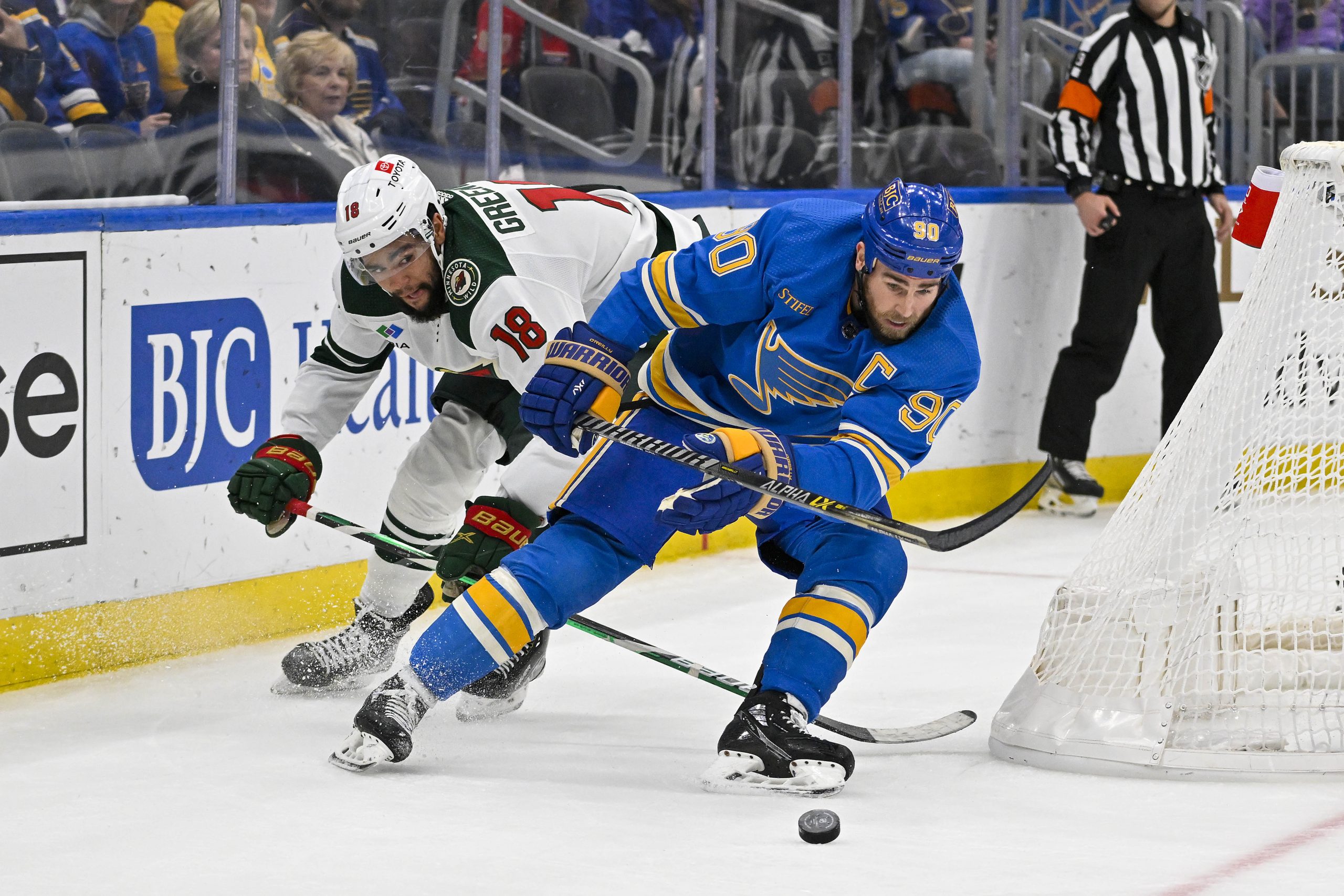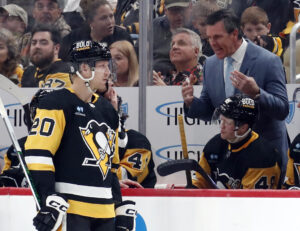Welcome to the latest installment of the “Since 2000” series. This week, we are finishing our look at the most influential St. Louis Blues trades since 2000 by looking at the top five.
Criteria Reminder
Before we jump into part two, here is a reminder about the criteria:
- What was the reason for the trade? Was it to become a contender? Was the team selling? Was it to shake up the roster?
- Were any stars brought in or traded away?
- Were the results of a trade a surprise for a positive or negative reason?
- Did the trade have effects lasting a few seasons?
Without further ado, let us finish the rankings!
Trade #5 on February 18, 2011
The Tampa Bay Lightning acquired defenceman Eric Brewer. The Blues acquired a 2011 third-round pick and the rights to defenceman Brock Beukeboom.
Analysis
Have Blues fans already forgotten about Brock Beukeboom? Well, he never played in an NHL game, so perhaps it makes sense if they did. This trade makes this list, in the top-five, because of the draft pick the Blues received. The Blues used that pick to draft goaltender Jordan Binnington. Binnington quickly became a legend in the NHL when he helped the Blues rally from a last-place spot in the Western Conference to winning the Stanley Cup in 2019. Furthemore, Binnington set a rookie record with wins in the playoffs with 16.
Brewer, as the player who came to the Blues in the Chris Pronger trade, was never a favourite of the fans. In fact, when his trade was announced at the next night’s Blues games, fans cheered. It is humourous that a player fans never liked was traded for the Stanley Cup hero. Binnington is likely to become the Blues all-time wins leader this season. The Blues clearly have benefited from this trade.
Trade #4 on June 25, 2010
The Ottawa Senators acquired defenceman David Rundblad. The Blues acquired a 2010 first-round pick.
Analysis
Like the trade before, this trade was franchise-altering. The Blues used the draft pick to draft Vladimir Tarasenko. Tarasenko is perhaps the best Blues player since Brett Hull. Tarasenko immediately became an elite scorer in the league. The four-time All-Star scored at least 30 goals in five-straight seasons. Furthermore, Tarasenko proved clutch in the playoffs. In the Blues run to the 2016 Western Conference Final, Tarasenko led the Blues with 11 goals in 2020 games. In the 2019 run to the Stanley Cup, he scored 11 goals in 26 games, including three in the Stanley Cup Final.
Injuries the following season led to a bitter relationship between Tarasenko and the Blues, resulting in Tarasenko requesting a trade. At the time, it seemed Tarasenko’s time in St. Louis was ending on a sour note. However, both parties overcame their differences. Tarasenko returned to form in the 2021-22 season, scoring 34 goals. Tarasenko was traded the following season, but his time with the Blues seemed to end on much better terms. As a result, it is not hard to think back on Tarasenko’s time with the Blues and truly appreciate the player he was and what he did for the team.
Trade #3 on March 13, 2001
The Phoenix Coyotes acquired forward Michal Handzus, forward Ladislav Nagy, a 2002 first-round pick, and rights to sign forward Jeff Taffe. The Blues acquired forward Keith Tkachuk.
Analysis
To paraphrase Cody Rhodes, the NHL has more than one royal family. The Tkachuk family is certainly one, and the Blues are honoured to have had Keith “Big Walt” Tkachuk play for them for nine seasons. In those nine seasons, Big Walt scored 208 goals. In eight of those seasons, Big Walt scored 20+ goals. He was an instant favourite in St. Louis. After being traded away at the 2007 Trade Deadline, Big Walt returned to the Blues that following offseason because he believed the team was in headed the right direction.
The elder of the Tkachuk hockey family had so many great moments as a Blue. It is hard to choose one that sticks out above the rest. Regardless, Big Walt’s career is something to be celebrated, and it should one day see him inducted into the Hockey Hall of Fame. Furthermore, when that time comes, Blues fans will get to celebrate his career once again when his number seven is raised to the rafters at Enterprise Center. Perhaps 2025 will be the year Keith Tkachuk enters hockey immortality.
Trade #2 on July 1, 2018
The Buffalo Sabres acquired forward Vladimir Sobotka, forward Patrik Berglund, forward Tage Thompson, a 2019 first-round pick, and a 2021 second-round pick. The Blues acquired forward Ryan O’Reilly.
Analysis
Like the aforementioned Ryan Miller trade, Doug Armstrong made the trade believing the Blues would be legitimate Stanley Cup contenders. The O’Reilly trade would not be the only move Armstrong made that offseason, but it was the one that had the most influence. After just three goals in the first three rounds of the 2019 Stanley Cup Playoffs, O’Reilly went off in the final. O’Reilly scored five goals in the final four games, helping the Blues win the Stanley Cup. Furthermore, O’Reilly was awarded the Conn Smythe Trophy as the playoff MVP.
O’Reilly spent four and a half seasons with the Blues. He was a two-time All-Star, a Selke Trophy winner, a Conn Smythe winner, and a Stanley Cup Champion. Furthermore, he spent two and a half of those seasons as the Blues captain. When the Blues made the trade, fans believed that this could be the team to win the first Stanley Cup in team history. The team did win, and it was O’Reilly, the big grab of the 2018 offseason, standing out among the rest.
Trade #1 on August 2, 2005
The Oilers aquired defenceman Chris Pronger. The Blues acquired defenceman Eric Brewer, defenceman Doug Lynch, and defenceman Jeff Woywitka.
Analysis
This is only the second trade on this list to have had a negative influence on the Blues. This trade takes the top spot as the most influential trade because it completely changed things for the Blues coming out of the lockout. Before the lockout, the Blues were on a streak of 25-consecutive playoff appearances. Furthermore, the team had won the Presidents’ Trophy in 2000 with Pronger winning the Norris and Hart Trophies. Pronger was the face of the Blues, and right before hockey finally returned, he was gone. In addition, the players the Blues got in return never did too much for the team. Brewer did serve as captain for a few seasons, but had little influence on the ice. Interestingly enough, trading Brewer did result in the Blues drafting Jordan Binnington. Not a total loss, right?
The first season without Pronger saw the Blues finish last in the Western Conference. The Blues went three seasons without making the playoffs. In addition, the Blues failed to finish above .500 in those seasons. The Pronger trade transitioned the Blues into a rebuild. The team did not become Stanley Cup contenders again until the 2011-12 season, seven seasons after the Pronger trade.
In Conclusion
As stated last week, this was not an easy list to make. There is no right or wrong way to order these ten trades. Some may even think some of these do not even belong in the top-ten. However, is that not what makes hockey great? We have the opportunity to look back on events and give our thoughts and opinions. Some of us look at somethings differently than others. If we disagree, we simply get the opportunity to engage in a discussion about hockey, which is never a bad thing.
This concludes this week’s installment of the “Since 2000” series. Next week’s category is still being determined, although it has been narrowed down to a few. Until then, have a great week! Children, it is the final countdown. If your first day of school is this coming week, have a great first day! Teachers, from one teacher to another, have a great year!
Main photo: Jeff Curry-USA TODAY Sports






